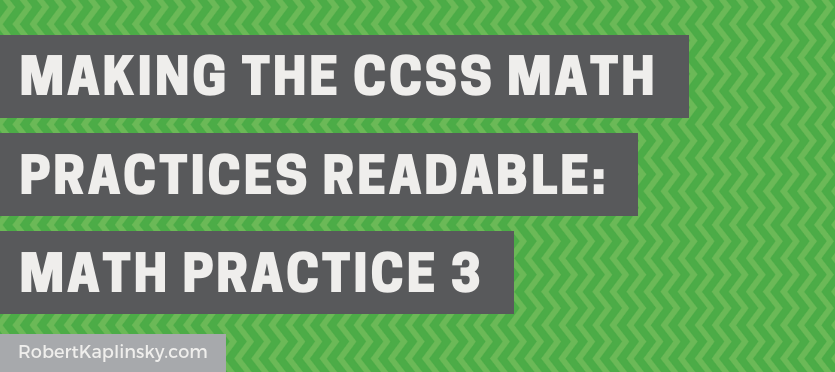This is the third of an eight blog post series where I’ll attempt to make a version of each of the Common Core State Standards’ Math Practices that educators, parents, and students can all understand. Simply put, the Math Practices are really tough to make sense of, which means that few educators have read them in full paragraph form and even fewer confidently understand them.
- My guiding principle comes from Antoine de Saint Exupéry who said “perfection is attained not when there is nothing more to add, but when there is nothing more to remove.” Certainly I could always add more details, but my goal is to make each standard as succinct as realistically possible and stop.
- I will make significant changes while still preserving what I believe to be each standard’s essence.
- I’ll also copy and paste the official math practice for comparison.
- I’ll add notes to explain my reasoning.
I realize that inevitably my version will also be flawed. Mainly I’m just curious to see if I can do any better. Thanks in advance for leaving me constructive criticism in the comments below so I can improve them.

Math Practice 3: Explain and defend your reasoning.
Mathematically proficient students can convince others that their reasoning is correct. This includes convincing others who have not solved the problem as well as those who have solved it but reached different conclusions.
Math Practice 3: Construct viable arguments and critique the reasoning of others.
Mathematically proficient students understand and use stated assumptions, definitions, and previously established results in constructing arguments. They make conjectures and build a logical progression of statements to explore the truth of their conjectures. They are able to analyze situations by breaking them into cases, and can recognize and use counterexamples. They justify their conclusions, communicate them to others, and respond to the arguments of others. They reason inductively about data, making plausible arguments that take into account the context from which the data arose. Mathematically proficient students are also able to compare the effectiveness of two plausible arguments, distinguish correct logic or reasoning from that which is flawed, and—if there is a flaw in an argument—explain what it is. Elementary students can construct arguments using concrete referents such as objects, drawings, diagrams, and actions. Such arguments can make sense and be correct, even though they are not generalized or made formal until later grades. Later, students learn to determine domains to which an argument applies. Students at all grades can listen or read the arguments of others, decide whether they make sense, and ask useful questions to clarify or improve the arguments.
- This standard rewrite was heavily influenced by this Levels of Convincing blog post.
- I cut out a large amount of the standard’s text, mostly consisting of examples of what this might look like. I don’t disagree with the examples, but I am trying to follow my guiding principle of “perfection is attained not when there is nothing more to add, but when there is nothing more to remove.” I believe that what is left is the essence of the standard.
- I was unsure if it sufficiently addressed the portion about “critique[ing] the reasoning of others” but felt that it was implied by “convincing others… who have solved it but reached different conclusions.”


Hi Robert. What a great series. The language you used really helps bring out the essence o each SMP. I think for SMP 3 I would add more about critiquing the reasoning of others. Your version focuses on the explainer but this standard is also about the listener. I’ know you struggled with that.
Yes, it was challenging. How would you modify it?